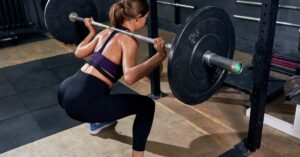Hey there, fitness enthusiasts and fellow squat enthusiasts! If you’ve ever found yourself wondering why your squat weight isn’t where you want it to be or why you’re not seeing the progress you expected, you’re in the right place.
We’ve all been there to that frustrating moment when you hit a wall in your squatting journey. But fear not, because in this blog post, we’re going to dive deep into the common reasons behind a stubbornly low squat weight and those maddening plateaus.
Whether you’re a newbie to squats or a seasoned lifter looking to break through barriers, we’ve got the insights and solutions to help you boost your squat game.
So, let’s lace up those lifting shoes and get ready to unlock the strength you know you have in you!
Unlocking the Secrets: Why Your Squat Weight is Stuck, and How to Boost Your Gains.
Several factors can contribute to a low squat weight and a lack of improvement in your squat strength.
To address this issue, it’s important to consider various aspects of your training and lifestyle.
Here are some possible reasons:
Form and Technique: Proper squat form is crucial for both safety and strength gains. If your technique is incorrect, it can limit the amount of weight you can lift and increase the risk of injury. Consider seeking guidance from a qualified coach or trainer to ensure your form is correct.
Consistency: Consistency in your training routine is essential for improvement. If you’re not consistently working on your squat, it can be challenging to see progress.
Ensure you have a structured training plan and stick to it consistently.
Progressive Overload: To increase your squat strength, you need to progressively overload your muscles. This means gradually increasing the weight you lift over time. If you’re using the same weight for an extended period, your body won’t adapt, and your strength gains will stagnate.
Nutrition: Your diet plays a significant role in your ability to build strength. Ensure you’re consuming enough calories, protein, and other essential nutrients to support muscle growth and recovery.
Rest and Recovery: Overtraining or inadequate rest can hinder progress. Muscles need time to recover and grow stronger.
Make sure you’re getting enough sleep and allowing your muscles to recover between squat sessions.
Weak Muscles: Weakness in supporting muscles, such as the core, glutes, and hamstrings, can limit your squat performance.
Incorporate exercises that target these muscle groups into your routine to improve overall strength.

Mobility and Flexibility: Poor mobility and flexibility can affect your squat form and depth. Perform mobility exercises and stretches to improve your range of motion and squat technique.
Programming: Your training program should be well-structured and address your specific goals.
Ensure that your program includes variations of squats, such as back squats, front squats, and goblet squats, to work on different aspects of your strength.
Psychological Factors: Mental barriers, such as fear of lifting heavy weights or lack of confidence, can also impact your performance.
Visualization, positive self-talk, and mental preparation can help overcome these barriers.
Plateau: It’s common to hit plateaus in strength training. If you’ve been training for a long time, your progress may slow down. In such cases, you might benefit from more advanced training techniques or periodization.
Injury or Health Issues: Past injuries or underlying health issues can affect your squat performance.
Consult with a healthcare professional if you suspect any health issues that may be hindering your progress.
To address your low squat weight and lack of improvement, it’s essential to assess these factors and make necessary adjustments to your training, nutrition, and recovery routines.
Tracking your progress and seeking guidance from experienced lifters or trainers can also be valuable in overcoming these challenges.
Remember that progress in strength training takes time and dedication, so be patient and stay committed to your goals.
Further Explanations.
Let’s dive deeper and elaborate further on all the points mentioned.
Firstly though, let’s dive deeper into the importance of proper form and technique as well as the significance of consistency in your squat training:
Proper Form and Technique:
Safety: One of the most critical aspects of squatting with proper form is safety. Incorrect technique can place unnecessary stress on your joints, particularly your knees and lower back, increasing the risk of injury. For example, if you’re not maintaining a neutral spine or if your knees are collapsing inward, it can lead to long-term issues.
Efficiency: Proper form optimizes the recruitment of the targeted muscle groups, such as your quadriceps, hamstrings, glutes, and lower back. When your form is correct, these muscles can work together efficiently, allowing you to lift more weight and make better progress in strength gains.
Full Range of Motion: Correct squat form ensures that you’re utilizing the full range of motion, meaning you’re squatting to an appropriate depth. This helps in activating a broader range of muscle fibers and promoting muscle growth. It also enhances flexibility and mobility, which are essential for overall fitness.
Balance and Stability: Proper form promotes balance and stability. It ensures that your body is aligned correctly, preventing you from tipping forward or backward during the squat. This stability is crucial for lifting heavier weights and reducing the risk of accidents.

Long-Term Benefits: Squatting with proper form not only helps you lift more weight immediately but also provides long-term benefits. It reduces the wear and tear on your joints and minimizes the risk of chronic injuries that can hinder your progress in the future.
Consistency:
Muscle Adaptation: Consistency is key for muscle adaptation. When you consistently challenge your muscles through squatting, they respond by getting stronger over time. If you skip workouts or have an inconsistent training schedule, your muscles won’t receive the consistent stimulus needed for growth.
Neurological Adaptation: Consistent training also allows your nervous system to adapt to the movement pattern. Your body becomes more efficient at recruiting the right muscles and coordinating them, which leads to better performance and strength gains.
Progress Tracking: Consistency enables you to track your progress accurately. When you follow a structured training plan and perform squats regularly, you can see how your strength improves over weeks and months. This feedback is motivating and helps you adjust your training as needed.
Preventing Plateaus: Plateaus in strength training often occur when you’re not consistently challenging your muscles with progressive overload. Sticking to a routine and gradually increasing the weight or intensity of your squats can help you avoid these plateaus.
Habit Formation: Consistency in training helps form a healthy habit. When squatting becomes a regular part of your routine, it’s more likely to become a sustainable and lifelong practice, leading to lasting fitness benefits.
In all this, focusing on proper squat form and maintaining consistency in your training routine are both critical for long-term progress in strength and injury prevention.
Consider working with a qualified coach or trainer to ensure your form is correct, and create a structured training plan that you can stick to consistently to maximize your squatting gains.
let’s delve deeper into the concepts of progressive overload and nutrition in the context of improving your squat strength:
Progressive Overload:
Definition: Progressive overload is a fundamental principle in strength training. It means gradually increasing the demands placed on your muscles over time. This can be achieved by increasing the weight you lift, the number of repetitions, or the intensity of your workouts.
Mechanism: Progressive overload challenges your muscles to adapt and grow stronger. When you consistently lift heavier weights or perform more challenging squat variations, your body responds by increasing muscle size and neural adaptations, ultimately leading to greater strength.
Periodization: To effectively implement progressive overload, consider a structured training program with periodization. Periodization involves dividing your training into cycles, each with a specific focus. For example, you might have a period of higher volume (more reps and sets) followed by a period of heavier weights. This variation keeps your training stimulating and avoids plateaus.
Tracking: It’s crucial to track your progress when applying progressive overload. Keep a training log to record the weights lifted, repetitions, and sets for each squat session. This data helps you make informed decisions about when and how to increase the load.
Safety: While progressive overload is essential for gains, it’s equally important to prioritize safety. Ensure you progress gradually, and don’t attempt weights that compromise your form or risk injury. Safety should always come first.
Nutrition:
Caloric Intake: To build strength, you need to consume an adequate number of calories to support your workouts and recovery. If you’re in a caloric deficit (burning more calories than you consume), it can be challenging to build strength. Calculate your daily energy needs and ensure you’re eating enough to meet those requirements.
Protein: Protein is crucial for muscle repair and growth. Aim for an adequate protein intake, typically around 1.2 to 2.2 grams of protein per kilogram of body weight per day. Protein-rich foods like lean meats, poultry, fish, dairy, and plant-based sources like legumes and tofu can help meet your protein needs.
Carbohydrates and Fats: Carbohydrates provide the energy needed for intense workouts, while healthy fats are essential for overall health. Include a balanced mix of carbohydrates and fats in your diet to support energy and recovery.
Hydration: Staying well-hydrated is often overlooked but crucial for muscle function and recovery. Dehydration can negatively affect your strength and performance, so drink an adequate amount of water throughout the day.
Micronutrients: Ensure you’re getting a variety of vitamins and minerals through a well-balanced diet or supplements if needed. These micronutrients play essential roles in muscle function and overall health.
Timing: Consider the timing of your meals. Consuming a combination of carbohydrates and protein before and after your workout can aid in recovery and muscle protein synthesis.
Consultation: If you have specific dietary concerns or goals, it’s advisable to consult with a registered dietitian or nutritionist who can create a personalized nutrition plan tailored to your needs.
Incorporating progressive overload into your training routine and maintaining a balanced and nutritious diet are key components of improving your squat strength and overall athletic performance. These principles work in synergy to help you achieve your fitness goals.
Let’s explore the importance of rest and recovery as well as the role of weak muscles in squat performance in more detail:
Rest and Recovery:
Recovery Time: Adequate rest and recovery are essential for muscle growth and overall progress. When you perform strength training exercises like squats, you create microscopic muscle damage. This damage is repaired during the recovery phase, making your muscles stronger and more resilient.

Sleep: Quality sleep is crucial for recovery. During deep sleep stages, the body releases growth hormone, which aids in muscle repair and growth. Aim for 7-9 hours of quality sleep each night to maximize recovery.
Nutrition: Post-workout nutrition plays a role in recovery. Consume a balanced meal or snack containing protein and carbohydrates within a few hours after your squat session to replenish glycogen stores and support muscle repair.
Active Recovery: Light, low-impact activities like walking, cycling, or yoga on rest days can help with active recovery. These activities increase blood flow to muscles, which can alleviate soreness and promote healing.
Listen to Your Body: Pay attention to how your body feels. If you’re experiencing excessive soreness, fatigue, or signs of overtraining (such as decreased performance, irritability, or sleep disturbances), it may be a sign that you need more rest.
Weak Muscles:
Core Strength: A strong core is essential for stabilizing your spine during squats. Weak core muscles can lead to poor posture and an increased risk of injury. Incorporate exercises like planks, Russian twists, and leg raises to strengthen your core.
Glute Strength: The glutes are powerful muscles that contribute significantly to squat performance. Weak glutes can lead to issues like the “butt wink” (posterior pelvic tilt) during squats. Exercises like hip thrusts, Bulgarian split squats, and lunges can help strengthen the glutes.
Hamstring Strength: Strong hamstrings provide balance and stability during squats. Exercises like Romanian deadlifts and hamstring curls can help build hamstring strength.
Balance and Symmetry: It’s crucial to maintain balance and symmetry in muscle development. Neglecting certain muscle groups can lead to imbalances, which may affect your squat form and overall performance. A well-rounded strength training routine that targets all major muscle groups is essential.
Form and Technique: Focus on maintaining proper form during exercises that target weak muscle groups. Poor form can lead to injury or further muscle imbalances. Consider working with a trainer to ensure you’re performing exercises correctly.
Incorporating adequate rest and recovery into your routine and addressing weaknesses in supporting muscle groups will contribute to improved squat performance.
Remember that strength gains are a holistic process that involves not only squatting but also taking care of your body and addressing any imbalances or weaknesses that may be holding you back.
let’s explore the importance of mobility and flexibility as well as the significance of well-structured programming in relation to improving your squat performance:
Mobility and Flexibility:
Range of Motion: Mobility and flexibility are crucial for achieving proper squat depth and form. If you have limited mobility in your ankles, hips, or thoracic spine, it can restrict your ability to perform a full-depth squat comfortably.
Common Limitations: Common mobility limitations that affect squatting include tight hip flexors, calf muscles, and ankle dorsiflexors, as well as limited thoracic spine mobility. These limitations can lead to issues like a forward-leaning torso, an inability to maintain an upright posture, or difficulty reaching parallel depth in your squat.
Dynamic Warm-Up: Incorporate a dynamic warm-up routine before your squat sessions. This may include exercises like leg swings, hip circles, and ankle mobility drills. These movements help increase blood flow and improve joint mobility.
Static Stretching: After your workouts or on rest days, perform static stretching exercises to target tight areas. Focus on stretches for the hip flexors, calves, hamstrings, and hip adductors. This will help alleviate tightness and improve overall flexibility.
Foam Rolling and Self-Massage: Foam rolling and self-myofascial release techniques can also be beneficial for improving mobility. Rolling the quadriceps, hip flexors, and calves can release tension and improve flexibility.
Consistency: Mobility and flexibility gains come with consistent practice. Incorporate these exercises into your routine regularly to see lasting improvements in your squat form and depth.
Programming:
Variation: A well-structured training program should include variations of squats to target different aspects of strength and prevent plateaus. Variations like back squats, front squats, goblet squats, and single-leg squats can work different muscle groups and movement patterns.
Specific Goals: Your training program should align with your specific goals. If your primary goal is to increase squat strength, your program should prioritize squat variations and accessory exercises that support squatting. However, if you have broader fitness goals, your program may include a mix of strength, mobility, and endurance exercises.
Progression: Ensure your program has a clear progression plan. This means gradually increasing the intensity, volume, or complexity of your squats over time. Tracking your progress and adjusting your training plan accordingly is crucial for continual improvement.
Recovery Days: Include recovery days in your programming. These days can involve lighter workouts, mobility work, or complete rest to allow your muscles and central nervous system to recover from intense squat sessions.
Periodization: Consider periodization within your programming. This involves cycling through different training phases, such as hypertrophy, strength, and power, to target various aspects of fitness. Periodization can help you make steady gains without overtraining.
Consultation: If you’re unsure about designing a well-structured program tailored to your goals, consider consulting with a qualified fitness trainer or coach. They can create a personalized plan that optimizes your squat performance and overall fitness.
Incorporating mobility and flexibility exercises into your routine, along with a well-structured training program that includes squat variations and proper progression, will contribute to improved squat performance, better form, and long-term gains in strength and mobility.
let’s explore the psychological factors, plateaus in strength training, and the potential impact of injuries or health issues on your squat performance:
Psychological Factors:
Fear and Confidence: Fear of lifting heavy weights or a lack of confidence can be significant barriers to progress. These psychological factors can lead to hesitation and self-doubt during your squats. To overcome them:
Practice visualization: Mentally rehearse successful squat sessions, imagining yourself lifting with confidence and perfect form.
Positive self-talk: Replace negative thoughts with positive affirmations. Encourage yourself and focus on your strengths.
Mental preparation: Develop a pre-squat routine that includes deep breathing, visualization, and positive self-talk to build confidence before each lift.
Mind-Muscle Connection: Developing a strong mind-muscle connection is also essential. Concentrate on feeling the muscles you’re working during squats, which can enhance your control and confidence in the movement.
Plateau:
Common in Strength Training: Hitting plateaus is a common occurrence in strength training. After an initial period of rapid progress, your gains may slow down. This is partly due to your body adapting to your routine and partly due to the diminishing returns of training.
Advanced Techniques: To break through plateaus, you may benefit from advanced training techniques such as:
Periodization: As mentioned earlier, structured periodization can help you vary your training stimulus and continue making progress.
Deload Weeks: Occasionally, take a week to reduce training intensity to allow your body to recover fully.
Strength Training Variations: Incorporate advanced squat variations like box squats, pause squats, or accommodating resistance (using bands or chains) to challenge your muscles in new ways.
Change Rep Ranges: Alter your repetition ranges to shock your muscles into growth. For example, if you’ve been doing lower reps for strength, try higher-rep sets for hypertrophy.
Patience and Persistence: Plateaus can be frustrating, but they’re a natural part of strength training. Stay patient, stay consistent, and keep pushing through. Sometimes, it’s the determination to keep going that ultimately leads to breakthroughs.
Injury or Health Issues:
Past Injuries: Previous injuries, if not fully healed or rehabilitated, can limit your squat performance and even lead to compensatory movement patterns that affect your form. Consult with a physical therapist or sports medicine specialist to address any lingering issues and receive guidance on safe squatting.
Underlying Health Issues: Underlying health conditions, such as joint problems or chronic pain, can impact your squat performance. If you suspect any health issues, it’s essential to consult with a healthcare professional for a proper diagnosis and guidance on how to adapt your training.
Rehabilitation: In some cases, rehabilitation exercises may be necessary to address and prevent recurring injuries. These exercises can help strengthen the affected areas and improve your overall squat performance while minimizing the risk of injury.
In other words, addressing psychological factors, adapting your training approach to overcome plateaus, and addressing any lingering injuries or health issues are essential steps in improving your squat performance and ensuring your safety and progress in strength training. Remember that a holistic approach to training, which includes both physical and mental aspects, is key to long-term success.
A complete tabular on this topic here.
Here’s a complete tabular breakdown of the reasons why your squat weight may be low and why you might not be seeing improvement, along with corresponding explanations for each factor:
| Factors | Explanations |
|---|---|
| 1. Form and Technique | Proper form is crucial for safety and strength gains. Incorrect technique can limit your lifting capacity and lead to injury. It’s essential to ensure your form is correct. |
| 2. Consistency | Consistency in training is vital for progress. Irregular workouts make it challenging to see improvements in strength. A structured training plan helps maintain consistency. |
| 3. Progressive Overload | Increasing the weight you lift over time is necessary for strength gains. Using the same weight for an extended period can lead to stagnation in progress. |
| 4. Nutrition | Diet plays a significant role in muscle growth and recovery. Inadequate calorie and protein intake can hinder strength development. |
| 5. Rest and Recovery | Overtraining or insufficient rest can impair progress. Muscles need time to recover and grow stronger. Quality sleep and recovery are crucial. |
| 6. Weak Muscles | Weakness in supporting muscles (e.g., core, glutes, hamstrings) can limit squat performance. Strengthening these muscles is essential for overall strength improvement. |
| 7. Mobility and Flexibility | Poor mobility and flexibility can restrict squat form and depth. Regular mobility exercises and stretches can improve range of motion and technique. |
| 8. Programming | A well-structured training program is essential. Variations of squats and progression plans are necessary to target different aspects of strength and prevent plateaus. |
| 9. Psychological Factors | Mental barriers like fear and lack of confidence can impact performance. Techniques like visualization and positive self-talk can help overcome these obstacles. |
| 10. Plateau | Plateaus are common in strength training. Advanced techniques, periodization, and persistence are key to breaking through plateaus and making continued progress. |
| 11. Injury or Health Issues | Past injuries or underlying health conditions can affect squat performance. Consulting a healthcare professional may be necessary to address and prevent issues. |
This table provides a comprehensive overview of the factors that can contribute to a low squat weight and a lack of improvement. Addressing these factors systematically can help you make progress in your squat strength and overall fitness goals.
Conclusion.
In conclusion, a low squat weight and a lack of improvement can stem from a combination of factors, including issues with form, inconsistency in training, inadequate progression, poor nutrition, insufficient rest, weaknesses in supporting muscles, limited mobility, program structure, psychological barriers, plateaus, and past injuries or health concerns.
Identifying and addressing these factors systematically, with a focus on proper technique, consistency, progressive overload, balanced nutrition, rest, and holistic training approaches, can help overcome limitations and lead to improved squat performance and strength gains over time.

Hey there, it’s Mike Rrsq, the Editor-in-Chief over at Jsquat.com, and I’m absolutely obsessed with all things squat fitness! I’ve been lucky enough to get some serious recognition for my work in this field. With a solid background in the fitness and wellness industry, I’ve been there right from the get-go, helping shape this website into what it is today.
You see, I’m not just the boss around here; I’m also a passionate contributor. I love sharing my insights through my articles, and trust me, they’re not your run-of-the-mill stuff. Each piece I write is a labor of love, filled with my expertise and real-world experience in the fitness universe. So, if you’re into fitness and looking for some inspiration, you’re in the right place!

